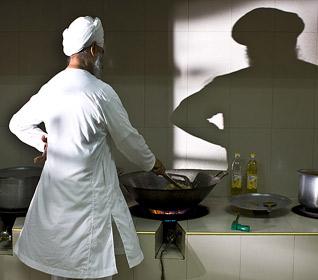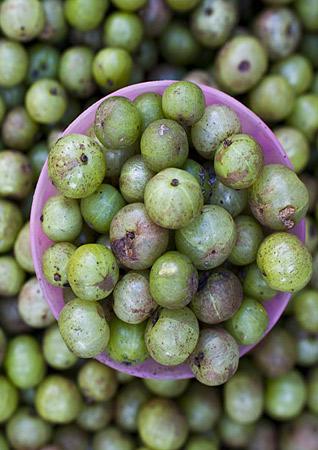Cuisine
Of Gooseberries & Mr. Singh, The Punjabi Cook
by ROBYN ECKHARDT
Mr. Singh came to Gat Luang's gurdwara from Bangkok and, before that, Punjab. For six years he's been granthi and cook at this eighty-year-old center of Sikh worship in the Gat Luang neighborhood.
When we first visited the gurdwara's kitchen last February, as part of our project to document daily life in this historic neighborhood, Mr. Singh was back home in Punjab, and the institution's weekly Friday dinner was prepared instead by a trio of female members. It was good, but there was something about the way our host at the temple spoke of Mr. Singh that made us want to revisit and see him in action.
His kitchen is spotless. Walking into the gurdwara on a Friday afternoon, we're encloaked in an intense fugue of spices. I expect to encounter a corresponding tumult in the kitchen. Not so. Stainless steel gleams and light bounces off pristine white tiles. On the stove, big pots and a huge wok are arranged in a neat row, each perfectly centered on its burner. Prepared fresh ingredients sit in little bowls arranged tidily on a corner of the counter.
Mr. Singh works alone in the hot space preparing a five-dish meal for sixty, yet his kurta and pajami - white, as his position requires - show no trace of perspiration, no splotches of stray curry.
He moves slowly, gracefully on bare feet, floating from burner to burner, between sink and refrigerator. He doesn't rush but everything gets done. When we arrive Mr. Singh is dicing his homemade paneer, holding a hunk of cheese in one hand and cutting it into cubes with a serious looking curved blade held in the other. The rest of the cheese sits on the counter, beautifully swaddled in a gauzy white scarf as if it had been styled for a photograph.
When he's finished dicing the paneer Mr. Singh deep-fries a few cubes, dusts them with garam masala, and offers us a taste. It's the best I've eaten. Made with milk taken that morning from cows at Chiang Mai University it's buttery and clean, without the rubbery texture that often plagues commercially made paneer. Then he offers hot samosa stuffed with curried potatoes, to dip into tangy tamarind sauce. And there is kheer, more of that creamy milk, lightly sweetened ("For us, it would be made sweeter," our host tells us.), laced with cardamom and floating vermicelli and a few tapioca pearls, served hot in metal bowls.
When we arrived Mr. Singh, with his heavy brows, full beard and lush moutache seemed remote and unapproachable, even a bit fierce. But as we praise his food his eyebrows shoot up and his face crinkles into a smile. He is proud of his skill in the kitchen. "You must return tonight for dinner," he says, and we will.
On the counter by the sink in the kitchen are a stainless steel pitcher of cool water and a bowl of amla - Indian gooseberries - a seasonal delicacy eaten with spicy dips by northern Thais. At first bite the hard, pitted fruit has no flavor, and then it's sour and bitter, with an astringent finish that sucks all moisture from the mouth.
When you eat this strange fruit, water drunk afterwards tastes shockingly sweet. Mr. Singh likes to make amla into a chutney. "Next time you come," he smiles.
A Punjabi saying:
Aamle da Khaada
Aur
Syaaney da kehaa,
baad vich acchhaa lagdaah ay
Roughly translated - 'Just as the gooseberry has little flavor at first, but leaves a sweet aftertaste, so is advice of the elders - seemingly meaningless at first, the wisdom becomes obvious later!'
[Courtesy: Eating Asia. Edited for sikhchic.com]
December 2, 2011
Conversation about this article
1: Sangat Singh (Kuala Lumpur, Malaysia), December 02, 2011, 7:53 PM.
The most important ingredient in the preparation of "Guru ka Langar' is love and recitation of gurbani while it is being cooked. That's why you can never produce tastier daal and parshadas elsewhere.
2: Kanwarjeet Singh (Franklin Park, New Jersey, U.S.A.), December 04, 2011, 12:28 AM.
Sangat Singh ji, you took the words right out of my mouth - very well said, Sir. Although the purpose of langar these days is totally defeated in gurdwaras - making a simple langar of sabzi and daal with parshadey while singing verses from gurbani has been substituted by specialized sevadars who are more like kitchen pardhans. It is a matter of making quick langars with no recitation of gurbani. The food is no more simple and the number of items on the plate are mind boggling. No wonder that most of the sangat doesn't connect to the langar any more. The same can be said of the way gurbani is recited in the gurdwaras - quick, packaged kirtans followed by 150 words per minute 'waheguru, waheguru'. There is no peace of mind or peace of stomach anymore. Perhaps this is the reason our younger generations prefer to leave the gurdwara out of their schedule.
3: Sangat Singh (Kuala Lumpur, Malaysia), December 06, 2011, 8:30 PM.
I remember those days when mothers would count every grain of wheat with a 'Waheguru' on their lips, for the Guru ka Langar. I remember the rolling of seviaa(n) with Waheguru jap. We used to call them 'Waheguru Seviaa(n)' and would perhaps get a share of 500 gms. of it. That was the way of 'Guru ka Langar' that I wistfully remember.





